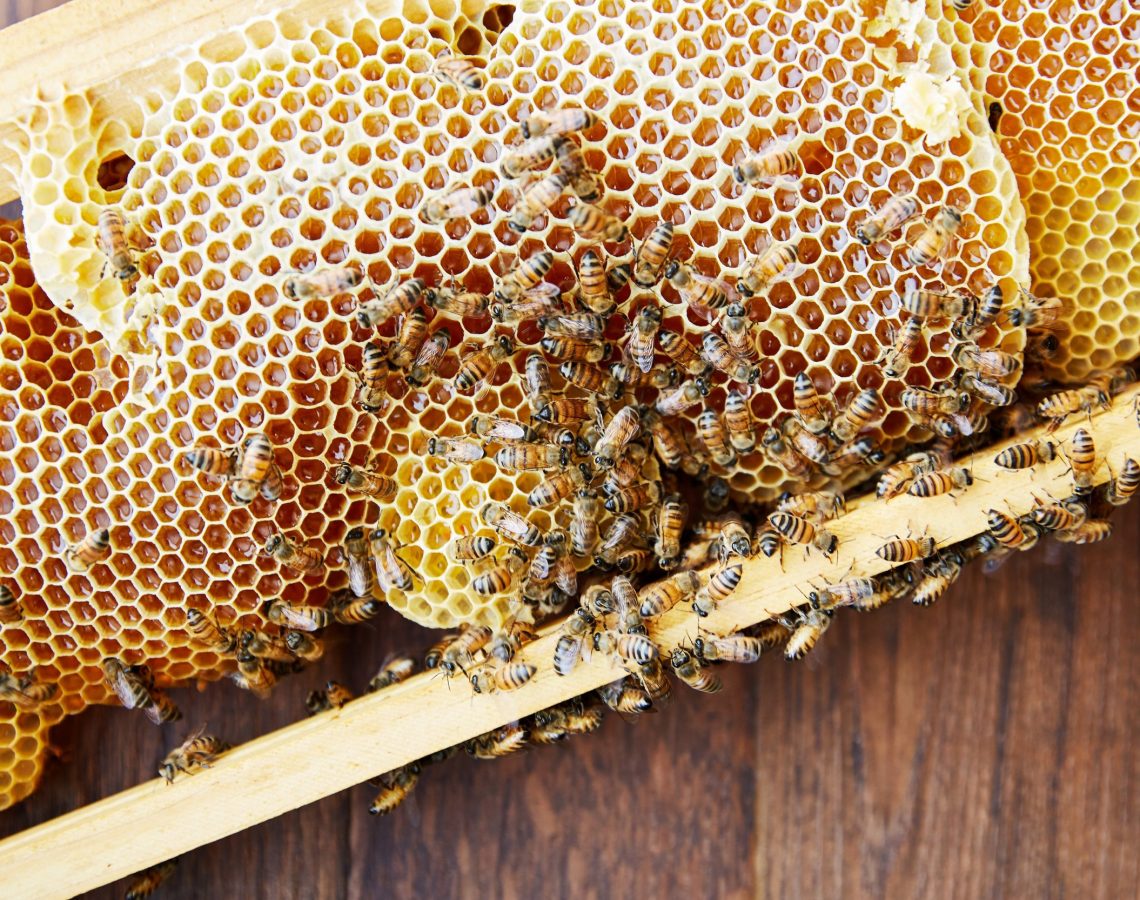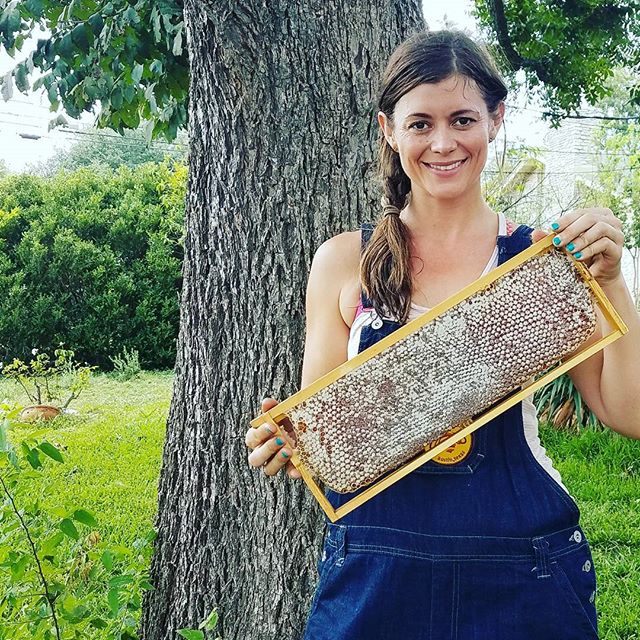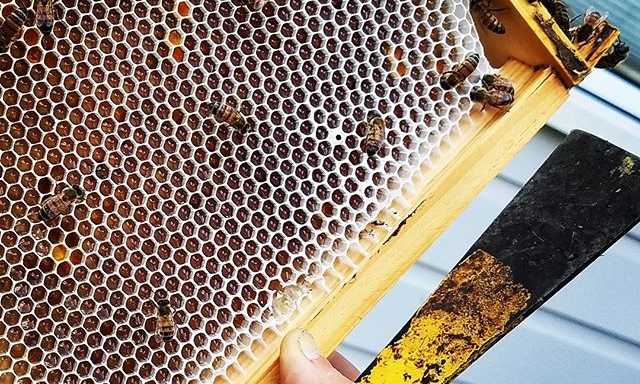What is Comb Honey?


Comb honey, in simplest terms, is the rawest form of honey available. The worker bee “architects” build tiny beeswax hexagons to give their young a place to develop and grow, to allow for the storage of pollen and nectar, and of course, a place to house the honey they produce. When you buy a jar of honey, the beekeeper has either crushed the comb to squeeze out the honey or used a centrifuge to sling the honey from the wax. The honey is then filtered and placed in jars.
Comb honey skips all those steps! We take the frames whose hexagons are filled only with honey, cut that comb honey into squares, and place it in a box for you to take home. No human hands have come into contact with your honey. Comb honey is raw honey packaged in its own edible package!
A century ago, comb honey was a very common product. In fact, it was more common to find comb honey than it was to find jars of honey. These days the only beekeepers that generally produce comb honey are small-scale or hobbyist beekeepers. Why? Comb honey does take a bit more nuance and patience to produce. Also, a beekeeper that uses a centrifuge to jar honey will reuse the wax comb hexagons after the honey is removed, which allows them to produce more honey much more quickly.
Comb honey is a gorgeous natural wonder: tens of thousands of bees working together to build perfect hexagons that are the exact same size and shape that fit perfectly together over and over again.
Why choose comb honey?
Bees make each of the hexagon containers of comb with their own ‘lid’. We leave them intact when we cut comb honey. Comb honey is not filtered..not even a little bit. It is cut out right from the hive. In fact, the comb honey hasn’t come into contact with human hands or any artificial matter. That means all the anti-microbial and healthy properties from the pollen, propolis, and enzymes make it to your breakfast table.

Comb honey is a much more exciting and interesting culinary experience. The beeswax makes comb honey more aromatic than jarred honey, and the smell, taste, and even consistency differs depending on the flowers the bees visited to produce the beeswax and honey. In addition to the aroma, the beeswax lends a texture, richness, and mouthfeel that regular old honey just can’t match. (Trust me. I’m a professional honey-eater.) It holds its shape, so instead of just getting watered down into your morning yogurt, it acts as more of a delicious, beautiful sweet garnish, instead of just a generic sweetener.
What is this beeswax stuff, and can you actually eat it?
Beeswax is produced by honey bees at age 12-18 days. When these bees consume great amounts of honey and nectar, they are able to produce very thin scales of beeswax from 8 organs on the underside of their abdomens. They use their back legs to gather up the wax, bring it up to their mouth parts, and then use their mandibles to chew and form it into those perfect hexagons. (See a slo-mo video of a bee chewing beeswax!)
Beeswax is completely safe for you to eat. When eating comb honey by itself, you will be left with a bit of wax in your mouth. You can spit it out, chew it like chewing gum, or swallow it. Many folks don’t like this waxy feeling in their mouth. If you are one of these, I strongly encourage you to not give up on comb honey so quickly. When consumed in conjunction with other food (for example, on a cracker with a bit of goat cheese, or with some yogurt or oatmeal), you aren’t left with any sort of wax in your mouth afterward! Got the basics down? Now spread the comb honey on a really hot biscuit, make a few grilled peanut butter and comb honey sandwiches, or bake a pizza with goat cheese, arugula, and comb honey, and prepare to be wowed.
Now that you know the skinny on comb honey, check out this for some fun ideas for comb honey recipes!
“Cone” honey
A note about “cone” honey. I am not sure how the trend of calling comb honey “cone honey” started, but I am here to set the record straight. It’s called COMB honey! Every time someone says ‘cone honey’, a tiny bee dies somewhere….
Ready to try comb honey with your next cheese plate or piece of warm bread?
Shop for our comb honey here!



My friend owns a small restaurant and he is always looking for suggestions to add or remove from the menu. I did not know that you can eat the comb honey and even make a pizza, sandwich, or a hot biscuit with it. I will recommend him to try comb honey and if it becomes a hit in his menu, then he can buy it in bulk to get better profits out it.
Hi Derek! So glad you stopped by to learn more about comb honey. Please do share with your chef friend! If he has any questions, he can email us through the website. We sell to lots of local restaurants and it’s a huge hit 🙂
Thank you! We love introducing folks to comb honey!
I am looking for local/regional honey as I suffer many allergies & was told to eat lots of raw Honey from my area. Is this a proven fact or a Myth?
Hi Carolyn! Thank you for stopping by the blog to learn more about honey. I’ve had people swear by local honey to alleviate their allergies. That said, studies have shown that honey does not improve allergies. There are a few reasons for this. First, bees make honey from nectar not pollen. While some pollen may get into the honey that you’re eating it is such a small amount that your body won’t build up immunity to that pollen. Second, that particular pollen may not be what you’re allergic to anyway. The leading causes of allergies are weeds, trees and grasses. These tend to be pollinated by wind, not insects. That said, honey has medicinal uses. It’s a good source of antioxidants, and some studies show it may improve cholesterol and lower triglycerides. It has antibacterial and anti inflammatory effects on wounds as well. So enjoy local, raw honey for it’s deliciousness and other benefits, but sadly, it isn’t going to cure your allergies.
“This website really has all of the info I wanted about this subject and didn’t know who to ask.”
Hi Judson, Thank you! I’m so glad our website has been a resource for you. Keep checking in as we will continue to post helpful and interesting information.
Do you have educational units on bees for elementary students available at you gift shop? (Do you have a gift shop?)
Do bees from the same hive use different types of nectar in the same comb honey? 🐝
Hello, Kristie. We do not currently have classes for elementary students but we have a great field trip option, I’ll send you more information via email.
And, yes, bees will bring in nectar from all sorts of plants. Depending on the time of year and the foraging options, some comb will be a single variety but other comb can have multiple nectar sources.
If you’re in the area, please stop by our shop at the honey ranch where we can answer more of your questions. We’re open Thursdays 10a-2p, Fridays 2p-7p, and Saturdays 9a-2p.